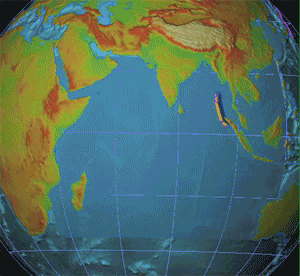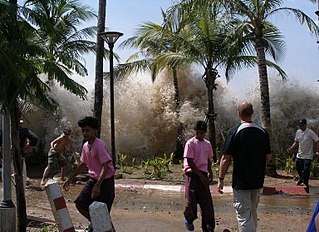Indian Ocean Tsunami
The Indian Ocean Tsunami was a catasthropic tsunami that occured on December 26, 2004. It was triggered by a magnitude 9.1 to 9.3 earthquake off the coast of Sumatra, Indonesia. It killed 230,000 to 280,000 people in 14 countries. The tsunami was considered one of the deadliest natural disasters in recorded history. The countries that have recorded casualties in order by death tool are: Indonesia, Sri Lanka, India, Thailand, Somalia, Myanmar, Maldives, Malaysia, Tanzania, Seychelles, Bangladesh, South, Yemen and Kenya.
Indian Ocean Tsunami Facts
- The Indian Ocean tsunami happened on Sunday, December 26, 2004 at 7:59 AM local time.
- The tsunami was cause by a megathrust earthquake with a magnitude of 9.1 to 9.3 off the coast of the Indonesian island of Sumatra when the Indian tectonic plate was subducted (force under) by the Burma tectonic plate.
- The tsunami caused death in 14 countries: Indonesia, Sri Lanka, India, Thailand, Somalia, Myanmar, Maldives, Malaysia, Tanzania, Seychelles, Bangladesh, South, Yemen and Kenya
- The total death tool was estimates at 230,000–280,000.
- Indonesia suffered the most death and distruction: 130,736 confirmed death, 37,063 missing and displaced more than 500,000.
- The highest recorded wave was 51 meters (167.3 ft) at Lhoknga, a town in the Indonesian province of Aceh.
- Total damages was estimated to be $19.9 billion.
- The very first wave reached the shore of Malacca in the island of Car Nicobar, India, five minutes after the earthquake.
- In Meulaboh, Indonesia, the sea receded about 500 meters and followed by an advancing small tsunami. The second and third destructive waves arrived later. It exceeded the height of the coconut trees according to some survivor.
- Radar satellites analysis recorded that the heights of tsunami had a maximum of 2 feet in deep water.
- The total energy of the tsunami waves was equivalent to about five megatons of TNT - more than twice the total explosive energy used during all of World War II.
- The earthquake that triggered the tsunami released an energy equivalent to 26 megatons of TNT or equivalent to over 1,500 times the Hiroshima atomic bomb.
- In many places the waves reached as far as 2 kilometers inland.
- The tsunami as given various names, including the 2004 Indian Ocean tsunami, South Asian tsunami, Indonesian tsunami, Christmas tsunami and the Boxing Day tsunami.
- The farthest recorded death attributed to the tsunami was in Rooi Els, South Africa. It was 8,000 kilometers (5,000 miles) away from the earthquake epicenter.
- The earthquake and resulting tsunami happened on the weekend of Christmas holiday. Many foreigners vacationing in resorts of affected countries died. Sweden lost 543 citizens, while Germany lost 539.
- Combined, the earthquake and tsunami are considered the world's deadliest natural disaster since the Tangshan earthquake in China in 1976.
- The tsunami itself is considered the deadliest in history, beating the previous record of between 36,000 to 120,000 deaths caused by a tsunami that was triggered by the eruption of Krakatoa in 1883.
2004 Indian Ocean Tsunami Animation

This animation of tsunami caused by the earthquake shows how it radiated from the entire length of the 1,600 kilometer (990 mi) rupture.
